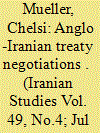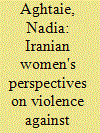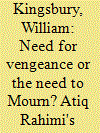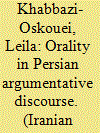|
|
|
Sort Order |
|
|
|
Items / Page
|
|
|
|
|
|
|
| Srl | Item |
| 1 |
ID:
145926


|
|
|
|
|
| Summary/Abstract |
From 1927 to 1932, wide-reaching negotiations took place between Reza Shah's court minister, ‘Abdolhossein Khan Teymurtash, and the British Legation in Tehran, the aim of which was to resolve all outstanding issues and to normalize relations between the two countries on the basis of a general treaty. This article examines these Anglo-Iranian negotiations with a particular focus on the thorniest issues—Iran's territorial claims in the Persian Gulf, particularly its claims to sovereignty over Bahrain, Abu Musa and the two Tunb islands. Though an agreement was never reached, an examination of the content and conduct of these negotiations offers some valuable insights into the unique features of Iranian nationalism and Iranian ambitions in the Persian Gulf during the Reza Shah period.
|
|
|
|
|
|
|
|
|
|
|
|
|
|
|
|
| 2 |
ID:
145933


|
|
|
|
|
| Summary/Abstract |
This essay examines certain common themes as well as conflicting voices in two extensive sets of Persian diaries, written almost a century apart, by Mohammad-Hasan Khān Eʿtemād al-Saltaneh (1843‒96), a long-time courtier and confidant of Nāser al-Din Shah Qajar (r. 1848‒86) and Asadollāh ʿAlam (1919‒78) a close associate and court minister of Mohammad-Reza Shah Pahlavi (r. 1941‒79). On the whole these diaries provide significant amounts of information about the inner workings of the court and the overall institutional setup of the Iranian state in the nineteenth and twentieth centuries. Although in writing their diaries these authors did not set out to produce a literary work, and nor did they intend to chronicle a general history, each in his own way captured his respective epoch and, within their limitations of time, scope, and insight, each reflected a broad range of private and social relationships. Also each in his own way echoed older ministerial voices, reminiscent of the voice that often resonates in the “mirror for princes” genre, of part player part intimate observer, and with a certain sense of admonition and resignation, lamenting the loss of an era which they felt was slipping away as they wrote.
|
|
|
|
|
|
|
|
|
|
|
|
|
|
|
|
| 3 |
ID:
145924


|
|
|
|
|
| Summary/Abstract |
In Iran surrealism is spoken of by artists and critics as a living element in art, long after its popularity in Europe and North America has waned. This article explores key features of the work of one of the most prolific contemporary Iranian artists, Ali-Akbar Sadeghi. While Sadeghi says that he thinks of himself as a “surrealist,” his work is distinguished from many self-professed surrealists in Iran: whereas the latter are concerned with representing metaphysical, even mystical, meanings, Sadeghi sees his art as a kind of intellectual exercise, presenting a dramatic theater in which the viewer engages in epistemological interrogation. Though Sadeghi's paintings are full of apparent references to surrealist themes and tropes from the past, here it is argued that his work is not so much a storehouse of surrealist content as a series of puzzles for the viewer to solve.
|
|
|
|
|
|
|
|
|
|
|
|
|
|
|
|
| 4 |
ID:
145927


|
|
|
|
|
| Summary/Abstract |
This study explores the perspectives of female Iranian students living in both Iran and the UK concerning violence against women. A qualitative approach, in the form of in-depth interviews, was carried out with 21 participants. Drawing on Stark's concept of “liberty crime” the research found that the participants, regardless of their country of residence, perceived violence against women (VAW) as denying the opportunity for equal personhood by stripping away the victim's sense of self. However, the scope of what was considered to be liberty crime was affected by the individual participants’ religious beliefs and their degree of acceptance of the Iranian state's gender ideology. The research highlighted the extent to which different forms of VAW are interlinked and combine in order to control and subjugate women irrespective of their country of residence.
|
|
|
|
|
|
|
|
|
|
|
|
|
|
|
|
| 5 |
ID:
145929


|
|
|
|
|
| Summary/Abstract |
It has been said of Atiq Rahimi's novel Earth and Ashes that the author intends it to convey a loss of any vision for a better future in Afghanistan. This essay neither disputes nor affirms this, but instead argues that this tone of disillusionment is sustained for a specific purpose—namely, to show how a belief in the Afghan requirement of vengeance helps sustain cycles of violence in Afghanistan. No critical work has explored this key motivation for the writing of the novel; this article does so using a method of close reading that enables an evaluation of the role the reader is afforded as part of this endeavor, be they natives or outsiders to this culture.
|
|
|
|
|
|
|
|
|
|
|
|
|
|
|
|
| 6 |
ID:
145932


|
|
|
|
|
| Summary/Abstract |
Languages have their own distinctive styles of argumentation. It seems some languages like Arabic and Persian have a preference for using the “oral” features of parataxis, formulaicity and repetition as persuasive devices in argumentation. The purpose of this article is first to examine these “oral” characteristics in Persian argumentation, and then to tie together the two areas of research: the study of orality and the study of metadiscourse. The article claims that these oral characteristics in Persian are means of gaining rhetorical effectiveness. Therefore, they should be considered as metadiscourse devices used to create a bond between writer and reader.
|
|
|
|
|
|
|
|
|
|
|
|
|
|
|
|
| 7 |
ID:
145931


|
|
|
|
|
| Summary/Abstract |
The purpose of this article is to analyze the interaction between different interpretations of Islamic jurisprudence in Iran and state law. It focuses on the public legal discourse about the new Family Draft Law in 2007–08, especially Article 23 regulating polygamous marriages and removing necessity for the first wife's permission. The participants in this public legal debate, which took place on the internet and in the media, were civil society organizations, especially women's organizations, the Shiite clergy, and state representatives. The article argues that even in a non-democratic, theocratic state such as the Islamic Republic of Iran, public discourse promoted by the named actors can challenge and influence state legislation. The removal of Article 23 from the Draft confirms this argument, but in the law of 2013 the requirement for the first wife's permission is not found. By looking at the arguments brought forward in the public discourse, the article demonstrates that the arguments are mainly “Islamic,” and none refers to international human rights, as this seems to be a kind of taboo in the political discourse.
|
|
|
|
|
|
|
|
|
|
|
|
|
|
|
|
| 8 |
ID:
145925


|
|
|
|
|
| Summary/Abstract |
Shi‘ism, perhaps more than any other current of Islam, places emphasis on numerous forms of commemorative culture. Throughout the history of Shi‘ism, commemorative rituals have provided a comprehensive framework for interpreting a wide array of historical encounters between the Shi‘a and the dominant Sunni culture, thereby allowing Shi‘ism to construct itself as a community of learning and remembering. This self-construction required both a high degree of institutionalization as well as specialists to preserve the religious identity of the Shi‘a and to transmit religious knowledge to the next generation. Madrasas (Islamic institutions of higher learning) as well as the shrines of the Shi‘i Imams and their progeny served as the best institutions to achieve these goals. This paper argues that Safavid madrasas were not only centers for disseminating religious knowledge and preserving Shi'a intellectual heritage. They also rearticulated and contemporized the community's past through the active memorializing of pivotal events in the religious calendar of the Shi‘a. More specifically, the paper delineates the nature and scope of religious rituals and rites carried out in the Madrasa-ye Sultānī and a number of other madrasa-mosque complexes of Safavid Isfahan in order to explore the process by which the Shi‘i past was contextualized or contemporized as salient to suit the needs of Safavid power and society.
|
|
|
|
|
|
|
|
|
|
|
|
|
|
|
|
| 9 |
ID:
145928


|
|
|
|
|
| Summary/Abstract |
This article focuses on the development of the tobacco industry in Iran during the seventeenth and eighteenth centuries. It uses this discussion as an entry point to inquire about the early modern Iranian economy. Using a wide range of primary and secondary sources, it makes several historiographical interventions. In explaining what the development of a completely new agrarian industry means in Iranian society, the paper suggests that innovation and intensification may not have been completely absent in agriculture and that in contrast to the way some of the available literature tends to argue, the Iranian economy may not have experienced continuous decline in all sectors throughout the seventeenth and eighteenth centuries. In addition, this article contends that the tobacco industry helped bring about the rise of merchants and landowners in Iranian society, and with that the further development of mass consumption and ever-increasing cycles of production and accumulation that expanded the commercialization of agriculture, domestic and international trade networks, and Iran's agrarian economy.
|
|
|
|
|
|
|
|
|
|
|
|
|
|
|
|
|
|
|
|
|